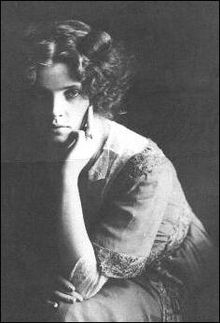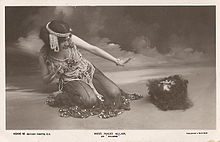Maud Allan
Maud Allan , nee Beulah Maude Durrant , (born August 27, 1873 in Toronto , Ontario , Canada , † October 7, 1956 in Los Angeles , California , USA ) was a Canadian-American dancer .
Life
Maud Allan was born the second child and only daughter (she had an older brother) to the itinerant shoemaker William Durrant and his wife Isabella. When Maud was five, the family moved to San Francisco in search of better job opportunities . There Maud studied music with the aim of becoming a concert pianist. In 1895 she continued her education at the Royal Academic University of Music in Berlin . At the end of 1897, her brother Theo Durrant was arrested in San Francisco for the murder of two young women, sentenced to death in January 1898 and executed.
In order to finance her stay in Germany, Maud tried various jobs. Among other things, she worked as a model for cosmetic products, carried out tailoring and designed corsages.
Belgian music critic Marcel Remy became her mentor and wrote the music for The Vision of Salome , which became her major work. Max Reinhardt's production of Oscar Wilde's Salome (1904) influenced Maud Allan's interpretations. She began her career as a dancer with her debut at the Vienna Conservatory on December 24, 1903.
There followed appearances and a. in Brussels (1904), Liège (1905) and Berlin (1905/06). She decided to give up studying music. The first performance of The Vision of Salome took place on December 2, 1906 in Vienna's Carltheater . Her dance was not judged to be a mere imitation of Isadora Duncan , although her dance was certainly influenced by Duncan and other dancers.
An engagement in the Munich Schauspielhaus only came about as a closed event due to the censorship. Allan's movements had an undeniable sensual component, as did her poses and costumes. On May 7, 1907, she performed at the Théâtre des Variétés in Paris one day before Richard Strauss ' opera premiere Salome at the Théâtre du Châtelet . For a short time she was a member of the Loïe Fuller Company.
In Marienbad she danced before King Edward VII , who recommended her to the Palace Theater in London . The premiere there on March 8, 1908 was a triumphant success. This guest performance did not end until November 1909. It made them a symbol of the Edward VII era . The year before, she published her autobiography My Life and Dancing .
Her less successful appearances in Saint Petersburg and Moscow were followed by an American tour in 1910. The score for her oriental ballet Khamma came from Claude Debussy , but it was never performed. In November 1911 she went on tour in South Africa and made the acquaintance of the Cherniavsky Trio in Johannesburg . From 1913 to 1915 they made a guest tour to India, Australia and Asia.
In 1916 Maud Allan returned to London to relaunch her career after a two-year absence. She became an involuntary main character in a newspaper scandal. The journalist and MP Noel Pemberton-Billing claimed in his newspaper Vigilante on January 26, 1918 to know of the existence of a "Black Book" in which 47,000 names of British homosexuals were listed. At the beginning of February, JT Grein organized two private performances in which Allan appeared as Salome. Lord Arthur Neville Chamberlain had personally arranged for a ban on public appearances . On February 16, 1918, Pemberton-Billing commented on these appearances in his Vigilante in an article entitled Cult of the Clitoris . In it he accused Allan of being a lesbian and of owning this "black book". After the trial of Noel Pemberton-Billin, Maud Allan stayed in London for a short time. As her reputation was tarnished by the scandal and her popularity declined, she decided to return to Los Angeles.
There she played the lead role in the film The Rugmaker's Daughter . With the ballet Noir the Slave , conducted by Ernest Bloch , she toured the United States in 1916. In 1918 she appeared in a production of the Independent Theater Society in London in Oscar Wilde's Salome . Further guest tours took her to South Africa in 1920 with the Cherniavsky Trio and to Egypt and Malta in 1928.
In 1932 she appeared in a small role in Max Reinhardt's production The Miracle . It was probably during this time that she established a dance school in her West Wing residence in London . 1938 last appearance in Redlands Bowl.
In mid-1941 Maud Allan returned to Los Angeles for good. There she died 15 years later.
Filmography
- 1915: The Rug Maker's Daughter
Fonts
- My life and dancing. Autobiography , Everett, London 1908
literature
- Felix Cherniavsky: Maud Allan and her art , Dance Collection Press, Toronto 1998, ISBN 0-929003-35-7
- Felix Cherniavsky: The Salome dancer. The life and times of Maud Allan , McClelland & Stewart, Toronto 1999, ISBN 0-7710-1957-2
- Brygida M. Ochaim, Claudia Balk: Variety dancers around 1900. From sensual intoxication to modern dance, exhibition by the German Theater Museum in Munich October 23 , 1998 - January 17 , 1999 , Stroemfeld, Basel 1998, ISBN 3-87877-745-0
Web links
- Meet the Artist - Maud Allan
- Gilded Serpent presents ... Maud Allan: La Femme Fatale
- Maud Allan in the Internet Movie Database (English)
- Maud Allan in the Internet Broadway Database (English)
| personal data | |
|---|---|
| SURNAME | Allan, Maud |
| ALTERNATIVE NAMES | Durrant, Beulah Maude (maiden name) |
| BRIEF DESCRIPTION | Canadian-American dancer |
| DATE OF BIRTH | August 27, 1873 |
| PLACE OF BIRTH | Toronto , Ontario , Canada |
| DATE OF DEATH | October 7, 1956 |
| Place of death | Los Angeles , California , United States |


